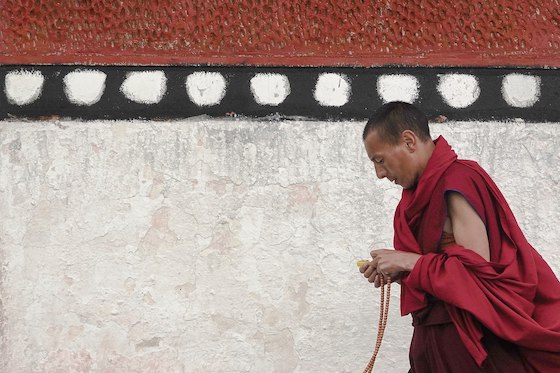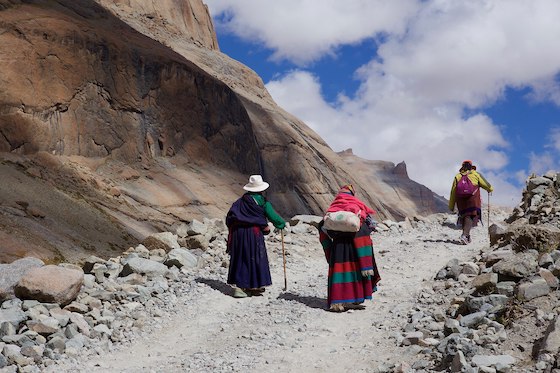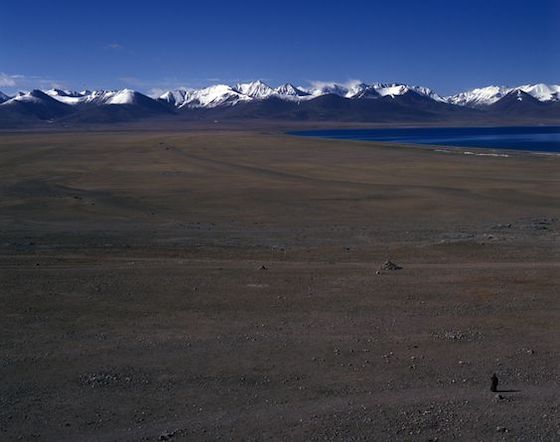What is Kora or Circumambulation?
The word circumambulation comes from the Latin circum (around) and ambulare (to walk).
The Tibetan word kora (བསྐོར་བ།) means the act of walking around or circumambulating a sacred place or object. Tibetan Buddhists do kora as a form of pilgrimage and meditation. Circumambulation of temples or deity images is an integral part of Tibetan Buddhist devotional practice.

A Tibetan pilgrim practices kora or circumambulation. Photo by Orly Liu, Wikimedia Commons
Tibetans generally use the word nékor (Tibetan: གནས་སྐོར) to refer to this type of pilgrimage which is a “circling around an abode” or the general practice of circumambulation. The sacred place or object is a né or néchen (Tibetan: གནས་ཆེན) and it has the power to transform those who circle it.
The more powerful the sacred space the greater the merit. Pilgrims can also increase the merit by circumambulating a holy place repeatedly or an auspicious number of times. Kora is a form of walking meditation and is often performed while chanting mantras, counting mala beads, or spinning prayer wheels which have prayers rolled up inside them.
Tibetan Buddhists circumambulate in a clockwise direction, whereas Bön pilgrims traditionally circumambulate counterclockwise.
Sacred Places for Kora or Circumambulation
There are various types of sacred places or né for kora.
Sacred Natural Places: One of the most sacred sites for Tibetan Buddhists is Mount Kailash, a prime example of a sacred natural place. Tibetans call it Gang Rinpoche (གངས་རིན་པོ་ཆེ) which can be translated “precious jewel of snows”. Pilgrims of several religions believe that circumambulating Mount Kailash on foot is a spiritually beneficial practice that can brings merit on the path to enlightenment. Other famous sacred places for kora include the Tibetan lakes Manasarovar, Yamdrok and Namtso.

Tibetans doing kora on pilgrimage at Mount Kailash or Gang Rinpoche. Photo by Jean-Marie Hullot, Wikimedia Commons
Human-Made Places: Examples of these include stupas, monasteries, temples and hermitages. Many people may be familiar with photographs from Nepal showing people performing kora around the Swayambhunath and Boudhanath stupas in the Kathmandu Valley. Similarly, Tibetans circumambulate the Potala Palace and the Jokhang temple in Lhasa. In Dharamsala, Tibetans walk around the building housing Library of Tibetan Works and Archives because it houses sacred texts.
A Holy Person: A holy person, such as his Holiness the Dalai Lama, can be considered a né. In Dharamsala there is a circumambulation route around the Dalai Lama’s compound and Namgyal Monastery.

A lone Tibetan Buddhist nun performs kora or circumambulation around a set of low hills (Tashi Dor) that are occupied by religious hermits beside Lake Namsto in Tibet. Photo courtesy of Brian Harris
Kora in Monasteries and Nunneries
Tibetan nunneries and monasteries with their temples and precious books are sacred spaces. The act of walking around them generates religious merit and cultivates bodhicitta or an awakening mind.
Many monasteries and nunneries have a circumambulatory pathway. This enables monastics to do kora and take healthy daily walks in the open air.
Currently, the Tibetan Nuns Project is raising funds to help the nuns at Shugsep Nunnery and Institute build a circumambulatory path. This will allow the nuns an opportunity to do kora, a form of walking meditation, while at the same time enabling them to get safe, regular exercise for their health and wellbeing. You can learn more and donate here.

Morning Prostrations by Tibetans in the holy ity of Bodh Gaya. Photo courtesy of Olivier Adam.
Prostrations and Kora
A person doing kora is known as a né korwa (གནས་སྐོར་བ) “one who circles a né”. To increase merit, a kora can be performed by repeatedly prostrating oneself.
Through prostrations, Tibetan Buddhists seek to purify the body, speech, and mind, freeing oneself from delusions, negativity, and any bad karma. It is a form of spiritual devotion and mental training that, like other forms of Buddhist practice, was banned by the Chinese during the Cultural Revolution.
To do kora while prostrating the pilgrim stretches out full length on the ground, marks the spot where her or his fingertips reach, and then stands and steps forward to that spot, before prostrating again. To protect their hands and clothes from the rough ground, these pilgrims often wear leather aprons, knee pads, and gloves. Some people attach wooden planks to their hands to make stretching out easier.
Some of the Tibetan Buddhist nuns first supported by the Tibetan Nuns Project underwent an arduous prostration pilgrimage in Tibet before escaping to India. In 1989, a large group of over 150 Tibetan Buddhist nuns and monks undertook a pilgrimage from Lithang to Lhasa performing prostrations to equal the entire distance of about 1,200-miles. Here’s one nun’s story of that journey.

Pingback: Circling Sacred Sites is Good for You (Me) | Notes from the Hermit's Cave